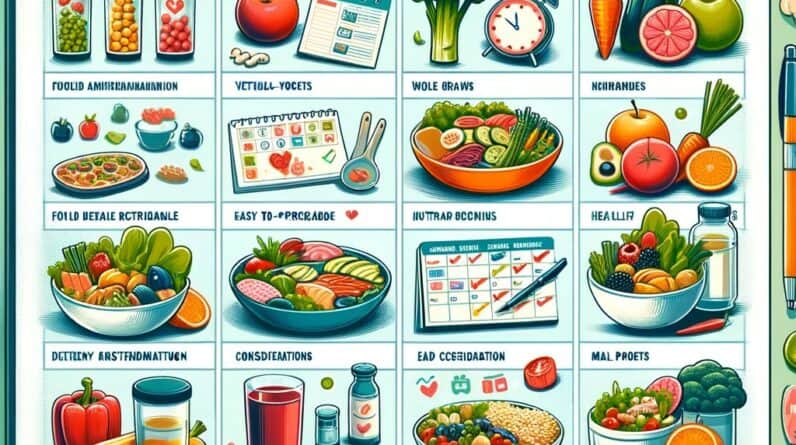Fueling Healthy Aging: How to Manage Dietary Restrictions with Ease
Concerns about aging and maintaining optimal health are common among individuals of all ages. As we age, dietary restrictions may become more prevalent, making it challenging to find and enjoy meals that meet our specific needs. However, managing these dietary restrictions doesn’t have to be a burden.

Dementia Discovery That is Leaving Doctors Speechless (Try This Tonight)
Better than Morphine For Joint Pain… Yet Safer Than Aspirin?
Retire With Freedom. Start Earning Extra Cash Today.
With the right knowledge and strategies, it is possible to fuel healthy aging while still enjoying tasty and nourishing meals.
In this article, we will explore effective ways to manage dietary restrictions with ease, ensuring that your nutritional needs are met without sacrificing flavor or variety. Whether you are coping with food allergies, intolerances, or medical conditions that require specific dietary adjustments, we have you covered.
From understanding ingredient labels to finding suitable substitutes and creating delicious recipes, we will provide practical tips to simplify your journey toward fueling healthy aging.
By implementing these strategies, you can navigate the world of dietary restrictions confidently, allowing you to fully enjoy and benefit from the foods you consume. So, let’s embark on this culinary adventure together and discover how to manage dietary restrictions with ease for a vibrant and fulfilling life.
Understanding dietary restrictions and their impact on healthy aging
Dietary restrictions can vary widely, depending on individual needs and health conditions. It is crucial to understand the specific restrictions you are dealing with to effectively manage them. Food allergies, intolerances, and medical conditions such as diabetes, high blood pressure, and heart disease often require dietary adjustments to ensure optimal health and well-being.
When it comes to healthy aging, managing dietary restrictions becomes even more critical. As we age, our bodies undergo various changes, including a decline in metabolism and changes in nutrient absorption. This makes it necessary to pay closer attention to our dietary choices.
By understanding the impact of dietary restrictions on healthy aging, we can make informed decisions that support our overall well-being.
Managing dietary restrictions involves more than just eliminating certain foods from our diets. It requires a comprehensive approach that focuses on providing adequate nutrition while still enjoying flavorful and satisfying meals.
By adopting a balanced and tailored approach to our diets, we can promote healthy aging and maintain a high quality of life.
Common dietary restrictions for older adults
As we age, certain dietary restrictions become more common due to changes in our bodies. Here are some of the most common dietary restrictions that older adults may encounter:
1. Food Allergies: Allergies to common foods such as peanuts, tree nuts, dairy, eggs, and shellfish can develop or worsen with age. These allergies can cause severe reactions and require strict avoidance of allergenic foods.
2. Food Intolerances: Intolerances to certain foods or food components, such as lactose or gluten, can cause digestive discomfort. Managing these intolerances involves avoiding or reducing consumption of the offending foods or finding suitable alternatives.
3. Medical Conditions: Conditions like diabetes, high blood pressure, and heart disease often require dietary modifications. For example, individuals with diabetes may need to monitor their carbohydrate intake, while those with high blood pressure may need to reduce sodium consumption.
4. Chewing and Swallowing Difficulties: Aging can sometimes lead to problems with chewing and swallowing, which may necessitate modifications to the texture and consistency of foods.
Understanding these common dietary restrictions is crucial for managing them effectively and ensuring optimal health and well-being as we age.

The importance of proper nutrition for healthy aging
Proper nutrition plays a significant role in healthy aging, regardless of dietary restrictions. As we age, our bodies require specific nutrients to support various bodily functions, maintain muscle mass, promote bone health, and boost immune function.
Adequate nutrition can also help prevent chronic diseases and improve overall cognitive function.
For individuals with dietary restrictions, meeting these nutritional needs can present additional challenges.
However, with careful planning and attention to nutrient-rich foods, it is possible to ensure optimal nutrition while adhering to dietary restrictions. Here are some key nutrients to focus on:
1. Protein: Protein is essential for maintaining muscle mass and promoting tissue repair. Good sources of protein include lean meats, poultry, fish, eggs, dairy products, legumes, and plant-based protein sources like tofu and tempeh.
2. Fiber: Adequate fiber intake is important for digestive health and can help prevent constipation, a common issue among older adults. Fiber-rich foods include whole grains, fruits, vegetables, legumes, and nuts.
3. Omega-3 Fatty Acids: Omega-3 fatty acids have been shown to support heart health and brain function. Good sources of omega-3s include fatty fish like salmon and mackerel, walnuts, flaxseeds, and chia seeds.
4. Calcium and Vitamin D: Calcium and vitamin D are crucial for maintaining bone health and preventing osteoporosis. Dairy products, fortified plant-based milks, leafy greens, and fortified cereals are excellent sources of these nutrients.
By focusing on these key nutrients and incorporating them into a well-balanced diet, individuals with dietary restrictions can ensure they are meeting their nutritional needs and promoting healthy aging.
Tips for managing dietary restrictions while still enjoying meals
Managing dietary restrictions can sometimes feel restrictive and overwhelming.
However, with the right strategies, it is possible to navigate these restrictions while still enjoying delicious and satisfying meals. Here are some practical tips to help you manage dietary restrictions with ease:
1. Read Ingredient Labels: When grocery shopping, carefully read ingredient labels to identify any allergens or ingredients that may not be suitable for your dietary restrictions.
Look out for hidden sources of allergens or common ingredients like gluten or added sugars.
2. Plan Meals: Meal planning is a valuable tool for individuals with dietary restrictions. By planning your meals in advance, you can ensure you have all the necessary ingredients on hand and avoid last-minute stress. Consider using meal planning apps or websites to simplify the process.
3. Experiment with New Recipes: Embrace the opportunity to try new recipes that cater to your dietary restrictions. There are countless online resources and cookbooks available that provide delicious and creative recipes for various dietary needs. Get creative in the kitchen and explore new flavors and ingredients.
4. Focus on Whole Foods: Emphasize whole, unprocessed foods in your diet. These foods are typically lower in allergens and artificial additives, making them a safer choice for individuals with dietary restrictions. Incorporate plenty of fruits, vegetables, whole grains, lean proteins, and healthy fats into your meals.
5. Communicate Your Needs: When dining out or attending social gatherings, don’t hesitate to communicate your dietary restrictions to the host or restaurant staff. Many restaurants are accommodating and willing to make modifications to their dishes to accommodate your needs. It’s important to advocate for yourself and ensure you can enjoy a safe and satisfying meal.
By implementing these tips, individuals with dietary restrictions can navigate their daily food choices with confidence and enjoy meals that are both delicious and nourishing.
Strategies for meal planning and preparation with dietary restrictions
Meal planning and preparation are essential components of managing dietary restrictions effectively. By having a plan in place, you can ensure that your meals meet your specific needs and reduce the likelihood of accidentally consuming restricted foods.
Here are some strategies to help you with meal planning and preparation:
1. Create a Weekly Meal Plan: Set aside some time each week to plan your meals. Consider your dietary restrictions, nutritional needs, and personal preferences when selecting recipes and creating your meal plan. Aim for a variety of flavors, textures, and nutrients.
2. Make a Detailed Grocery List: Based on your meal plan, create a comprehensive grocery list that includes all the ingredients you will need. This will help you stay organized and ensure you have everything on hand when it’s time to prepare your meals.
3. Prep Ingredients in Advance: Take advantage of your free time to prep ingredients in advance. Wash and chop vegetables, portion out snacks, and cook large batches of staples like grains or proteins that can be used in multiple meals throughout the week. This will save you time and make meal preparation more efficient.
4. Invest in Storage Containers: Having a variety of storage containers on hand will make it easier to store and transport meals. Opt for containers that are microwave-safe, freezer-friendly, and leak-proof. This will allow you to prepare meals in advance and have them readily available when needed.
5. Batch Cook and Freeze Meals: Consider batch cooking larger quantities of meals and freezing individual portions. This is particularly helpful for busy days when you don’t have time to cook. Simply thaw and reheat your pre-prepared meals for a quick and convenient option.
By implementing these meal planning and preparation strategies, individuals with dietary restrictions can ensure they always have nutritious and satisfying meals readily available.
Incorporating alternative ingredients and substitutions for dietary restrictions
One of the keys to managing dietary restrictions with ease is finding suitable alternatives and substitutions for restricted ingredients. Fortunately, there are numerous alternative ingredients available that can be used to create delicious and satisfying meals.
Here are some common dietary restrictions and their corresponding alternative ingredients:
1. Gluten-Free: For individuals with gluten restrictions, there are many gluten-free alternatives available, such as almond flour, coconut flour, quinoa, buckwheat, and rice-based products. These ingredients can be used to create gluten-free bread, pasta, and baked goods.
2. Dairy-Free: Those with dairy restrictions can opt for plant-based milks like almond, soy, or oat milk. Non-dairy yogurts, cheeses, and ice creams made from nuts or coconut are also readily available. These alternatives can be used in recipes or enjoyed on their own.
3. Egg-Free: Eggs can be replaced in recipes with ingredients like applesauce, mashed bananas, flaxseed meal, or chia seeds mixed with water. These alternatives work well in baking and can provide moisture and binding properties.
4. Sugar-Free: Individuals looking to reduce their sugar intake can turn to natural sweeteners like stevia, monk fruit extract, or erythritol. These sweeteners can be used in moderation to add sweetness to recipes without the added calories or blood sugar spikes.
5. Sodium-Restricted: For those needing to reduce sodium intake, herbs, spices, and citrus juices can be used to add flavor to meals without relying on salt. Experiment with different combinations to create tasty and satisfying dishes.
It’s important to note that when incorporating alternative ingredients and substitutions, it may require some experimentation to find the right balance of flavors and textures.
Don’t be afraid to try new things and adjust recipes to suit your tastes and dietary restrictions.
Social situations and dining out can present challenges for individuals with dietary restrictions.
However, with some planning and communication, it is possible to navigate these situations successfully. Here are some tips to help you navigate social situations and dining out with ease:
1. Research Restaurants in Advance: Before dining out, research restaurants in your area that offer options suitable for your dietary restrictions. Many restaurants now provide detailed menus and allergen information online, making it easier to identify suitable options.
2. Call Ahead: If you are unsure about the menu options or the restaurant’s ability to accommodate your dietary needs, call ahead to discuss your restrictions with the staff. This will allow you to confirm if they can make modifications or provide alternative dishes that meet your needs.
3. Ask Questions: When dining out, don’t hesitate to ask questions about the ingredients and preparation methods of dishes. It’s important to ensure that your food is prepared in a way that aligns with your dietary restrictions and avoids cross-contamination.
4. Be Prepared with Snacks: If you are attending a social gathering or event where the food options may be limited, it’s a good idea to bring along some snacks or a small meal that aligns with your dietary restrictions. This will ensure that you have something safe and satisfying to enjoy.
5. Communicate Your Needs: Whether dining out or attending a social event, communicate your dietary restrictions to the host or restaurant staff. By clearly expressing your needs, you can ensure that they are understood and accommodated.
Remember that it’s essential to advocate for yourself and your dietary restrictions. Most restaurants and hosts are willing to accommodate dietary needs when given advance notice and clear communication.
Seeking support and resources for managing dietary restrictions
Managing dietary restrictions can sometimes feel overwhelming, but it’s important to remember that you are not alone.
There are numerous resources and support networks available to help you along your journey. Here are some ways to seek support and find valuable resources:
1. Consult a Registered Dietitian: A registered dietitian can provide personalized guidance and support in managing dietary restrictions. They can help you create a tailored meal plan, provide recipe ideas, and offer advice on meeting your nutritional needs.
2. Join Support Groups: Seek out local or online support groups for individuals with similar dietary restrictions. These groups can provide a sense of community, shared experiences, and valuable tips and advice.
3. Utilize Online Resources: There are countless websites, blogs, and social media platforms dedicated to providing information and resources for individuals with dietary restrictions. Explore these platforms for recipe ideas, meal-planning tips, and guidance on managing specific dietary needs.
4. Attend Workshops or Classes: Look for workshops, cooking classes, or seminars that focus on managing dietary restrictions. These events can provide valuable insights, practical tips, and the opportunity to connect with others facing similar challenges.
Remember, seeking support and resources can help alleviate the stress and uncertainty often associated with managing dietary restrictions.
Don’t hesitate to reach out and connect with others who share similar experiences.
The role of exercise and physical activity in supporting healthy aging with dietary restrictions
While managing dietary restrictions is crucial for healthy aging, it’s equally important to incorporate regular exercise and physical activity into your lifestyle.
Exercise offers numerous benefits, including maintaining muscle strength, improving cardiovascular health, boosting mood, and supporting overall well-being.
Here are some ways to incorporate exercise into your routine while managing dietary restrictions:
1. Consult with Your Healthcare Provider: Before starting any exercise program, it’s essential to consult with your healthcare provider, especially if you have any underlying health conditions. They can provide guidance on suitable exercises and any necessary modifications.
2. Choose Activities You Enjoy: Find physical activities that you genuinely enjoy, as this will increase your chances of sticking with them long-term. Whether it’s walking, swimming, dancing, or yoga, engaging in activities you love will make exercise more enjoyable.
3. Adapt Exercises to Your Abilities: If you have physical limitations or restrictions, adapt exercises to suit your abilities. For example, if you have joint issues, opt
Conclusion: Empowering yourself to live a healthy and fulfilling life with dietary restrictions
Managing dietary restrictions can initially feel overwhelming, but with the right knowledge and strategies, it is possible to fuel healthy aging while still enjoying delicious and nourishing meals.
By understanding your dietary restrictions, reading ingredient labels, finding suitable substitutes, creating delicious recipes, and navigating dining-out situations, you can empower yourself to live a vibrant and fulfilling life.
Remember, managing dietary restrictions is not about deprivation or sacrifice but about finding creative ways to meet your nutritional needs while still enjoying the foods you love.
With the abundance of resources and support available, you can navigate the world of dietary restrictions with ease and embark on a culinary adventure that promotes healthy aging and overall well-being.
So embrace your dietary restrictions as an opportunity for culinary exploration and enjoy the journey towards fueling healthy aging.
Disclaimer: The information in this article is intended for educational and entertainment purposes only and should not be used instead of or contrary to that of a medical professional.
Before taking supplements, starting a new diet, or embarking on a new exercise regime please consult a medical or nutritional professional.
The owners of “Getting Healthy After 50” are not medical professionals and are simply redistributing information that is freely available on the internet.






